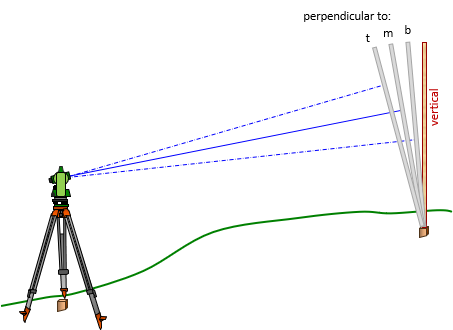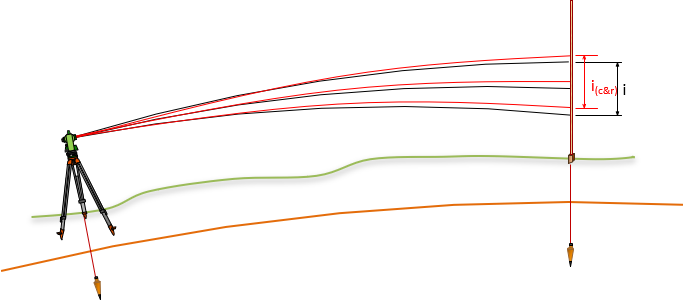3. Errors
Errors have to be considered in light of expected stadia accuracy. How accurate are stadia distances? The resolution of a level rod or stadia board is is 0.01 ft and any interval will generally have 2 or 3 significant figures. The stadia multiplier (100) has 3 significant figures, trigonometric values of zenith/vertical angles have more than 3. That means a distance will have 2 or 3 significant figures.
Let's look at examples of small and large intervals, both at 70° zenith angles
| small interval | |
| i = 5.60-5.38 = 0.22 ft (2 sf) horiz dist = (0.22x100) x sin(70°) = 20.7 = 21 ft (2 sf) vert dist = (0.22x100) x cos(70°) = 7.52 = 7.5 (2 sf) |
|
| large interval | |
| i = 7.71-3.28 = 4.43 ft (3 sf) horiz dist = (4.43x100) x sin(70°)= 416.28 = 416 ft (3 sf) vert dist = (4.43x100) x cos(70°)= 151.5 = 152 (3 sf) |
|
In both cases, the horizontal distance is good to the nearest foot. Any errors less than 0.5 ft would be below stadia's "noise level".
Vertical distance accuracy is a slightly different story. For distances less than 100 feet, vertical is good 0.01 ft; over 100 ft it is good to 1 ft.
Stadia shouldn't be used for long distances considering the difficulty reading three crosshairs at those long distances. What is the practical distance limit for staida? In most cases, stadia should be limited to 300-400 ft
Taking all this into consideration, systematic errors like earth curvature and refraction are generally too small to affect stadia. That doesn't mean, however, that care shouldn't still be exercised when measuring with stadia.
a. Instrumental
(1) Multiplier
(a) Description and Behavior
The stadia multiplier for modern instruments, with a few notable exceptions, is 100. Using an incorrect multiplier is a systematic error.
(b) Compensation
Procedural: An incorrect multiplier cannot be corrected procedurally.
Mathematical: Use the multiplier determined in XV. Equipment Checks and Adjustments Chapter D. Stadia for stadia reductions.
(2) Vertical circle index
(a) Description and Behavior
The vertical circle must be correctly oriented to gravity in order to measure the correct zenith or vertical angle. A rotation in the circle causes the angle to be too large or too small by the error amount. It behaves systematically.
(b) Compensation
Procedural: Because zenith or vertical angles are not measured direct and reverse in stadia work, reversion cannot be used to compensate the error. The index error causes all angles to be too large or too small by the same amount.
Modern total stations use gravity actuated vertical circles and have axis compensation as long as the instrument is level. This compensates any potential index error.
Mathematical: If the instrument does not automatically compensate, use the vertical circle index determined in XV. Equipment Checks and Adjustments Chapter D. Stadia for stadia reductions.
b. Natural
(1) Curvature and Refraction
(a) Description and Behavior
The effect on a Line of Sight (LoS) of curvature and refraction (c&r) is discussed in Topic III. Errors E. Systematic Errors. Quick review: curvature causes high readings, refraction low; curvature is the larger error of the two.
In stadia there are three LoSs. The black lines in Figure D-14 are the "true" LoSs, red are the LoSs because of c&r. The correct stadia interval is i, the displaced interval is i(c&r).
|
|
| Figure D-14 Curvature and Refraction |
Because all three LoS are close to each other, they're each affected the same amount so the displaced stadia interval is the same as the "true" interval.
However, the vertical/zenith angle is affected which in turn affects horizontal and vertical distances. Are the differences significant? Turning it around the other way, assume a we want a zenith angle accuracy of 0°00'04". Re-arranging Equation E-1 from II. Errors E. Systematic Errors, to solve for distance:

(This only takes into account earth curvature, but it has a greater effect than refraction.)
Considering even a wide stadia board is hard to read accurately at 800+ feet, we can consider curvature (and refraction) to be inconsequential errors.
(b) Compensation
None needed.
(3) Atmospheric distortion
(a) Description and Behavior
The atmospheric correction and refraction are based on an assumption that the atmosphere is either uniform or changing uniformly along the signal path. This is not always the case. Consider the atmosphere immediately above an asphalt surface on a sunny day - the heat emitted by the surface causes a local atmospheric anomaly which affects the signal path. Almost any surface will have a boundary layer of atmospheric disturbance if it has been subject to sunlight.
(b) Compensation
The effect of atmospheric anomolies can only be minimized or eliminated by not measuring through them although this isn't always practical. Strategies can include measuring on a cloudy day or early morning.
c. Personal
(1) Instrument set up
(a) Description and Behavior
Although horizontal and vertical stadia distances are less accurate than those determined by contemporary technologies, instrument setup errors still affect measurement quality. In total, the overall effect behaves randomly.
(b) Compensation
Careful setup and experience.
(2) Instrument height determination
(a) Description and Behavior
Using an incorrect instrument height will not affect horizontal or vertical distances. It will, however, affect elevations determined using Equation D-6. Incorrect instrument height is an additive systematic error.
(b) Compensation
Care should be exercised measuring instrument height, generally using a cloth tape or pocket rod.
(3) Level rod
(a) Description and Behavior
The level rod or stadia board must be held vertical or a systematic error will be introduced reading the rod interval
(b) Compensation
The only way to compensate is to hold the rod vertical using a rod bubble. Waving the rod, as in differential leveling does not work. The minimum reading for each crosshair occurs when the rod is perpendicular to each respective LoS, Figure D-15.
 |
| Figure D-15 Waving Rod Error |
(4) Parallax
(a) Description, Behavior, and Compensation
Parallax and its compensation are described in I. Basic Principles Chapter E. Bubbles, Axes, and Optics, Oh My! Its behavior is random.
(5) Reading errors
(a) Description and Behavior
Three crosshairs and a vertical angle are read by the instrument operator. Reading errors are random.
(b) Compensation
Careful field procedures; checking half-interval equality.
(6) Recording errors
(a) Description and Behavior
Mistakes.
(b) Compensation
Careful recording, verifying readings.
(7) Computations
(a) Description and Behavior
Mistakes
(b) Compensation
Careful computations.
